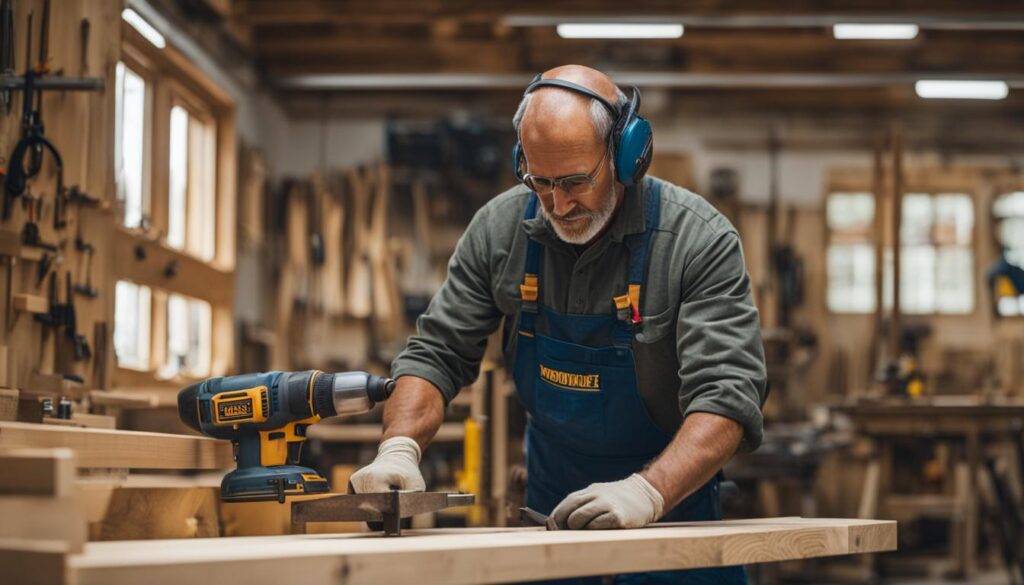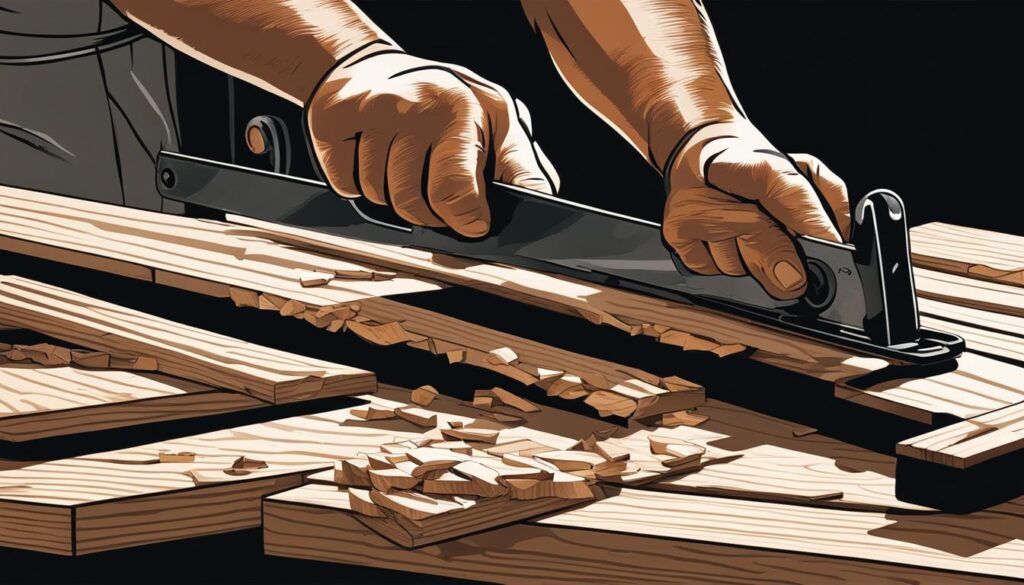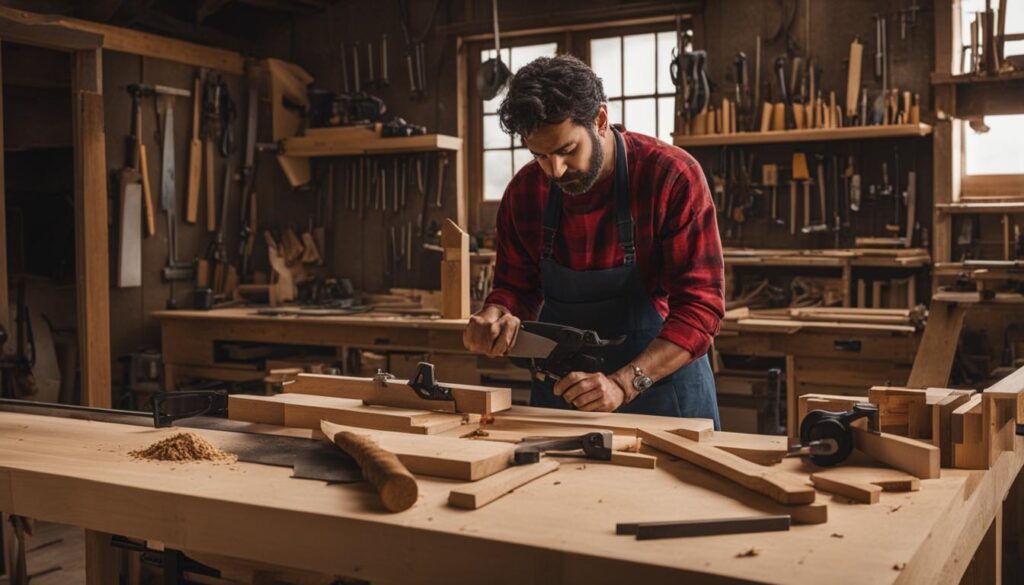We may earn money or products from the companies mentioned in this post.
Woodworking is a cherished hobby for many, but it can also be hazardous if proper safety measures are not taken. From using sharp tools to working with heavy machinery, every woodworker should prioritize safety to prevent accidents and injuries. In this section, we will cover the essential woodworking safety tips that every woodworker should follow.
Key Takeaways
- Woodworking safety is essential to prevent accidents and injuries
- Following safety guidelines and rules is crucial for ensuring a safe working environment
- Proper safety equipment and training can help minimize risks
- Safe practices should be incorporated into your woodworking routine to prevent accidents
- Adhering to specific safety guidelines for different woodworking tasks is necessary for maintaining safety
Importance of Woodworking Safety
Woodworking can be a fulfilling hobby or profession, but it also presents potential hazards that can cause serious injuries. Therefore, taking safety precautions is paramount to ensure a safe working environment. Whether you are a novice or a seasoned woodworker, always prioritize safety to prevent mishaps.
How to Stay Safe While Woodworking
Here are some essential safety precautions you should always keep in mind while woodworking:
- Wear appropriate personal protective equipment (PPE), including safety glasses or goggles, hearing protection, and a dust mask.
- Avoid wearing loose clothing, jewelry, or long hair that can get caught in machinery.
- Ensure good lighting in your workspace to avoid mistakes and accidents.
- Keep your workspace clean and organized, with all tools and machinery in their proper places.
- Use tools and machinery according to the manufacturer’s instructions and safety guidelines.
- Take breaks frequently to avoid fatigue and remain alert.
- Never rush a job or take shortcuts that compromise safety.
Essential Safety Precautions for Woodworking
Some additional safety precautions that can help you avoid accidents while woodworking include:
Always be attentive while using cutting tools and machinery, especially when handling sharp blades or bits. Never touch the cutting part of tools when they are in motion.
Woodworking safety requires a combination of common sense, caution, and appropriate safety gear. By following the necessary safety guidelines, you can minimize the risk of accidents and injuries and create a safe working environment for yourself.
Safe Practices in Woodworking
Woodworking is a rewarding craft, but it can also be dangerous if proper safety measures are not taken. To prevent accidents in woodworking, it’s essential to incorporate these safe practices into your routine:
- Wear appropriate safety gear: Always wear eye protection, a respirator, gloves, and earplugs when necessary. Loose clothing and jewelry should be avoided, and long hair should be tied back.
- Keep your workspace clean and organized: Cluttered workspaces can lead to accidents, so make sure all tools and materials are properly stored. A clean workspace also helps you focus on your task at hand.
- Understand your tools: Know how to properly use and maintain your tools before using them. This not only improves your work but also keeps you safe.
- Use the right tool for the job: Using the wrong tool can lead to accidents and poor results. Make sure you’re using the appropriate tool for the task at hand.
- Inspect your tools: Check your tools for damage or wear before use. Damaged tools can break or malfunction, leading to a dangerous situation.
- Follow instructions: Always follow the manufacturer’s instructions when using tools and equipment. This includes using the proper blades, bits, and accessories.
- Take breaks: Woodworking can be physically demanding, so take frequent breaks to avoid fatigue and maintain focus.
Following these safe practices in woodworking can help prevent accidents and injuries, creating a safer and more productive workspace. Always prioritize safety when pursuing your woodworking projects.
Woodworking Safety Equipment
Equipping yourself with the proper woodworking safety equipment is crucial for minimizing the risk of injuries or accidents. Here are some of the must-have safety gear and equipment to invest in:
| Equipment | Description |
|---|---|
| Safety goggles | Protect your eyes from debris, sawdust, and other hazards that may cause eye injuries. |
| Earplugs or earmuffs | Reduce the risk of hearing damage from the loud noise of power tools. |
| Dust mask or respirator | Prevents inhalation of harmful dust particles or fumes from chemicals or finishes. |
| Work gloves | Protect your hands from cuts, scrapes, and splinters. |
| Steel-toed boots | Protect your feet from heavy objects or tools that may fall. |
| Apron or work vest | Prevents your clothing from getting caught in machinery or tools. |
Investing in proper safety equipment may seem like an unnecessary expense, but it is a crucial step for maintaining a safe working environment in your woodworking shop. Don’t cut corners when it comes to your safety.
Woodworking Safety Training: Essential Tips for a Safe Environment
Proper woodworking safety training is crucial for both novice and experienced woodworkers. By acquiring the necessary knowledge and skills, you can ensure a safe working environment and minimize the risk of accidents and injuries.
Woodworking safety training covers a range of topics, from tool usage to specific safety guidelines. Here are some essential tips to keep in mind:
- Learn from a qualified instructor: Seek out training from a qualified instructor with experience in woodworking safety. They can provide guidance on proper tool usage, safety guidelines, and best practices.
- Familiarize yourself with specific tools: Each woodworking tool presents unique safety hazards. Before using any tool, make sure you understand its proper usage and safety guidelines.
- Wear appropriate safety gear: Personal protective equipment, such as safety glasses, earplugs, and gloves, must be worn at all times during woodworking. Invest in high-quality safety equipment to ensure maximum protection.
- Keep your workspace organized and clean: Cluttered workspaces increase the risk of accidents. Keep your workspace clean and organized, ensuring that tools are stored properly when not in use.
Additionally, consider seeking out online resources or books on woodworking safety to supplement your training. By continuously expanding your knowledge and skills, you can ensure that you are working as safely as possible.
Safety Guidelines for Woodworking
Woodworking involves various tools and techniques, each with their own set of safety guidelines. Here are some essential safety guidelines to keep in mind:
- Always wear protective equipment: Before starting any woodworking project, make sure to gear up with the necessary protective equipment. This includes safety glasses, ear protection, a dust mask, and gloves. Remember to choose the appropriate equipment for each task.
- Keep your workspace clean and organized: A clean and organized workspace can help prevent accidents. Make sure to keep your tools and materials organized and stored away when not in use. Sweep the floor regularly to avoid tripping hazards.
- Familiarize yourself with the tools: Before using any tool, make sure to read and understand the manual thoroughly. Learn how to properly operate, adjust, and maintain the tools. Avoid using any tool unless you know how to use it safely.
- Pay attention to your surroundings: Always be aware of your surroundings, especially when using power tools. Avoid distractions, such as talking on the phone, listening to music, or watching TV, while working. Make sure your workspace is well-lit and free of obstructions.
- Avoid loose clothing and jewelry: Loose clothing and jewelry can easily get caught in machinery, posing a serious hazard. Wear close-fitting clothing and remove all jewelry before working.
- Use the proper technique: Using the proper technique for each task is crucial to working safely. If you’re unsure about a technique, seek guidance from an expert or refer to an instructional book or video. Don’t take shortcuts or use improper techniques.
- Avoid distractions: Avoid distractions when working with power tools, such as talking on the phone, listening to music, or watching TV. Stay focused on the task at hand to avoid accidents.
- Do not rush: Rushing can lead to mistakes and accidents. Take your time and work at a comfortable pace. If you’re feeling tired or fatigued, take a break and rest.
- Be prepared for emergencies: Accidents can happen, even when taking proper precautions. Make sure to have a first-aid kit on hand and know how to use it. Have a phone nearby in case of emergencies.
Conclusion
Woodworking is a rewarding hobby and profession that requires the utmost attention to safety. By following the essential safety tips covered in this article, you can minimize risks and create a safe working environment for yourself and those around you. Remember, safety should never be compromised for the sake of productivity or convenience.
Implementing Safe Practices
Ensure that you incorporate safe practices such as keeping your working area clean and organized, wearing appropriate clothing, and focusing on your task at hand. Avoid distractions that can lead to accidents or injuries. By following these practices, you can minimize the risk of accidents and injuries, ensuring a safe working environment.
Investing in Safety Equipment
Equipping yourself with the right safety gear and equipment is crucial for woodworking. You should invest in gear such as protective eyewear, gloves, earplugs, and a dust mask to protect yourself from potential hazards. Always ensure that your equipment is well-maintained and in good working condition before use.
Seeking Necessary Training
Proper training is key to maintaining a safe woodworking environment. Seek out resources such as classes or online tutorials to acquire the necessary knowledge and skills to work safely. Remember that woodworking involves various tools and techniques, and it’s crucial to adhere to specific safety guidelines.
Adhering to Safety Guidelines
It’s important to adhere to specific safety guidelines that apply to different woodworking tasks. Remember to read and understand instruction manuals for tools and equipment before use. Avoid taking shortcuts or improvising, as they can be dangerous. Keep in mind that safety should always be a top priority.
FAQ
What are some essential woodworking safety tips?
Some essential woodworking safety tips include wearing appropriate safety gear, using tools properly, keeping the workspace clean and organized, and following the manufacturer’s instructions.
Why is woodworking safety important?
Woodworking safety is important because it helps prevent accidents and injuries, protects the woodworker’s health, and ensures a safe working environment for everyone involved.
What are some safe practices in woodworking?
Some safe practices in woodworking include using push sticks or blocks, securing workpieces properly, maintaining sharp and well-maintained tools, and avoiding distractions while operating machinery.
What safety equipment is necessary for woodworking?
Necessary safety equipment for woodworking includes safety glasses, hearing protection, respiratory protection, gloves, and dust collection systems, among others.
Is woodworking safety training important?
Yes, woodworking safety training is important as it provides the necessary knowledge and skills to work safely, understand potential hazards, and implement proper safety measures.
What are some safety guidelines for woodworking?
Some safety guidelines for woodworking include using sharp tools with caution, avoiding loose-fitting clothing or jewelry, working in a well-ventilated area, and maintaining a fire extinguisher nearby.
Affiliate Disclosure: This post may contain affiliate links. If you purchase through our link, we may receive a small commission, but at no additional cost to you. For more information, please see our Disclosure statement.



